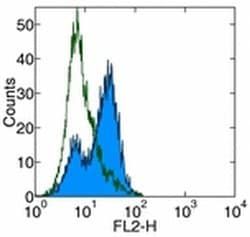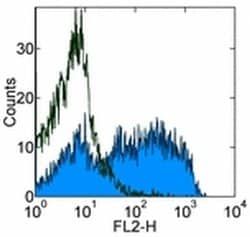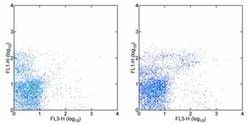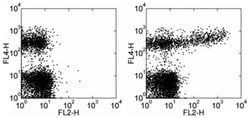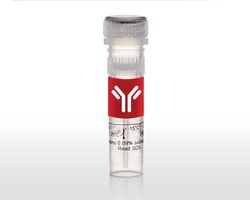50-121-09
IgE Monoclonal Antibody (23G3), Biotin, eBioscience™, Invitrogen™
Manufacturer: Fischer Scientific
Select a Size
| Pack Size | SKU | Availability | Price |
|---|---|---|---|
| Each | 50-121-09-Each | In Stock | ₹ 22,930.85 |
50-121-09 - Each
In Stock
Quantity
1
Base Price: ₹ 22,930.85
GST (18%): ₹ 4,127.553
Total Price: ₹ 27,058.403
Antigen
IgE
Classification
Monoclonal
Concentration
0.5 mg/mL
Formulation
PBS with 0.09% sodium azide; pH 7.2
Gene Accession No.
P06336
Gene Symbols
Ighe
Purification Method
Affinity chromatography
Regulatory Status
RUO
Gene ID (Entrez)
380792
Content And Storage
4° C, do not freeze
Form
Liquid
Applications
ELISA, Flow Cytometry
Clone
23G3
Conjugate
Biotin
Gene
Ighe
Gene Alias
Gm900; Ighe; Immunoglobulin E; Immunoglobulin heavy constant epsilon; ImmunoglobulinE
Host Species
Rat
Quantity
100 μg
Primary or Secondary
Primary
Target Species
Mouse
Product Type
Antibody
Isotype
IgG1 κ
Related Products
Description
- Description: The 23G3 monoclonal antibody reacts with the epsilon heavy chain of mouse IgE
- It does not react with other classes of mouse immunoglobulin including IgD, IgG, IgA, or IgM
- Applications Reported: The 23G3 antibody has been reported for use in flow cytometric analysis, and ELISA
- Applications Tested: The 23G3 antibody has been tested by ELISA and can be used at 1:5000-1:10000
- This 23G3 antibody has also been tested by flow cytometric analysis of IGEL cells, and can be used at less than or equal to 0.25 μg per test
- A test is defined as the amount (μg) of antibody that will stain a cell sample in a final volume of 100 μL
- Cell number should be determined empirically but can range from 10^5 to 10^8 cells/test
- It is recommended that the antibody be carefully titrated for optimal performance in the assay of interest
- Filtration: 0.2 μm post-manufacturing filtered
- IgE is one of the five classes of immunoglobulins found in mammals
- Monomers consist of two heavy (epsilon) chains with 4 Ig-like constant domains, and two light chains
- IgE plays an essential role in type I hypersensitivity (allergic responses such as hay fever, asthma, hives, anaphylatic shock) by binding to Fc receptors on basophils and mast cells
- Crosslinking of IgE bound to Fc receptors induces degranulation of mast cells and basophils that promote allergic manifestations
- IgE is also functionally important for immunity against parasites.
Compare Similar Items
Show Difference
Antigen: IgE
Classification: Monoclonal
Concentration: 0.5 mg/mL
Formulation: PBS with 0.09% sodium azide; pH 7.2
Gene Accession No.: P06336
Gene Symbols: Ighe
Purification Method: Affinity chromatography
Regulatory Status: RUO
Gene ID (Entrez): 380792
Content And Storage: 4° C, do not freeze
Form: Liquid
Applications: ELISA, Flow Cytometry
Clone: 23G3
Conjugate: Biotin
Gene: Ighe
Gene Alias: Gm900; Ighe; Immunoglobulin E; Immunoglobulin heavy constant epsilon; ImmunoglobulinE
Host Species: Rat
Quantity: 100 μg
Primary or Secondary: Primary
Target Species: Mouse
Product Type: Antibody
Isotype: IgG1 κ
Antigen:
IgE
Classification:
Monoclonal
Concentration:
0.5 mg/mL
Formulation:
PBS with 0.09% sodium azide; pH 7.2
Gene Accession No.:
P06336
Gene Symbols:
Ighe
Purification Method:
Affinity chromatography
Regulatory Status:
RUO
Gene ID (Entrez):
380792
Content And Storage:
4° C, do not freeze
Form:
Liquid
Applications:
ELISA, Flow Cytometry
Clone:
23G3
Conjugate:
Biotin
Gene:
Ighe
Gene Alias:
Gm900; Ighe; Immunoglobulin E; Immunoglobulin heavy constant epsilon; ImmunoglobulinE
Host Species:
Rat
Quantity:
100 μg
Primary or Secondary:
Primary
Target Species:
Mouse
Product Type:
Antibody
Isotype:
IgG1 κ
Antigen: IgA
Classification: Monoclonal
Concentration: 0.5 mg/mL
Formulation: PBS with 0.09% sodium azide; pH 7.2
Gene Accession No.: P01878
Gene Symbols: Igha
Purification Method: Affinity chromatography
Regulatory Status: RUO
Gene ID (Entrez): 238447
Content And Storage: 4° C, store in dark, DO NOT FREEZE!
Form: Liquid
Applications: Flow Cytometry
Clone: 11-44-2
Conjugate: Biotin
Gene: Igha
Gene Alias: IgA; Igh-2; Igha; immunoglobulin heavy constant alpha; ImmunoglobulinA
Host Species: Rat
Quantity: 100 μg
Primary or Secondary: Primary
Target Species: Mouse
Product Type: Antibody
Isotype: IgG1 κ
Antigen:
IgA
Classification:
Monoclonal
Concentration:
0.5 mg/mL
Formulation:
PBS with 0.09% sodium azide; pH 7.2
Gene Accession No.:
P01878
Gene Symbols:
Igha
Purification Method:
Affinity chromatography
Regulatory Status:
RUO
Gene ID (Entrez):
238447
Content And Storage:
4° C, store in dark, DO NOT FREEZE!
Form:
Liquid
Applications:
Flow Cytometry
Clone:
11-44-2
Conjugate:
Biotin
Gene:
Igha
Gene Alias:
IgA; Igh-2; Igha; immunoglobulin heavy constant alpha; ImmunoglobulinA
Host Species:
Rat
Quantity:
100 μg
Primary or Secondary:
Primary
Target Species:
Mouse
Product Type:
Antibody
Isotype:
IgG1 κ
Antigen: __
Classification: __
Concentration: __
Formulation: __
Gene Accession No.: __
Gene Symbols: __
Purification Method: __
Regulatory Status: __
Gene ID (Entrez): __
Content And Storage: __
Form: __
Applications: __
Clone: __
Conjugate: __
Gene: __
Gene Alias: __
Host Species: __
Quantity: __
Primary or Secondary: __
Target Species: __
Product Type: __
Isotype: __
Antigen:
__
Classification:
__
Concentration:
__
Formulation:
__
Gene Accession No.:
__
Gene Symbols:
__
Purification Method:
__
Regulatory Status:
__
Gene ID (Entrez):
__
Content And Storage:
__
Form:
__
Applications:
__
Clone:
__
Conjugate:
__
Gene:
__
Gene Alias:
__
Host Species:
__
Quantity:
__
Primary or Secondary:
__
Target Species:
__
Product Type:
__
Isotype:
__
Antigen: Ubiquitin
Classification: Monoclonal
Concentration: 0.5 mg/mL
Formulation: PBS with 0.09% sodium azide; pH 7.2
Gene Accession No.: P0CG47, P0CG48, P0CG49, P0CG50, P0CG51, P24051, P62979, P62982, P62983, P62984, P62986, P62987, Q63429, Q6ZWY3, Q71UM5
Gene Symbols: RPS27A, RPS27L, UBA52, UBB, UBC
Purification Method: Affinity chromatography
Regulatory Status: RUO
Gene ID (Entrez): 100912032, 192255, 22186, 22187, 22190, 50522, 51065, 6233, 64156, 67941, 681429, 7311, 7314, 7316, 78294
Content And Storage: 4° C, store in dark, DO NOT FREEZE!
Form: Liquid
Applications: Western Blot
Clone: eBioP4D1 (P4D1)
Conjugate: Biotin
Gene: RPS27A
Gene Alias: 0610006J14Rik; 1810034D23Rik; 2700054O04Rik; 40S ribosomal protein S27a; 40S ribosomal protein S27-like; 40S ribosomal protein S27-like protein; AI194771; AL033289; CEP80; CG5271; CG5271-PA; Chap1; Dmel\CG5271; Dmel_CG5271; Dub80; epididymis luminal protein 112; epididymis secretory protein Li 50; HEL112; HEL-S-50; hm:zeh0386; HMG20; hPLIC-2; HRIHFB2157; HUBCEP52; ik:tdsubc_1f2; l(2)04820; l(2)31Ei; LOC100912032; LOC101747587; male female sterile 31; mfs(2)31; mfs(2)48; mfs48; OTTHUMP00000200786; OTTHUMP00000201692; PLIC-2; polyubiquitin; polyubiquitin B; polyubiquitin C; poly-ubiquitin precursor; polyubiquitin-B; Polyubiquitin-C; polyubiquitin-C-like; RE44350p; ribosomal protein S27; ribosomal protein S27 like; ribosomal protein S27A; ribosomal protein S27a L homeolog; ribosomal protein S27a S homeolog; ribosomal protein S27-like; ribosomal protein S27-like protein; RPL40; RpS27; Rps27a; rps27a.L; rps27a.S; RpS27A-PA; RPS27L; S27A; similar to polyubiquitin; similar to ubiquitin-S27a fusion protein; Small ribosomal subunit protein eS27-like; Small ribosomal subunit protein eS31; tdsubc_1f2; TI-225; UB3-D; Uba52; UBA80; UBB; Ubb2; UBC; UBCEP1; UBCEP80; Ubi-f80; Ubi-m; Ubiq; Ubiquilin 2; ubiquitin; ubiquitin (34 AA) (1 is 2nd base in codon); ubiquitin and ribosomal protein S27a; ubiquitin B; ubiquitin C; ubiquitin carboxyl extension protein 80; ubiquitin copy 4; ubiquitin fusion 80; ubiquitin polyprotein (heat shock related); ubiquitin/ribosomal protein; ubiquitin-40S ribosomal protein S27a; ubiquitin-40S ribosomal protein S27a-like; ubiquitin-CEP80; ubiquitin-hybrid protein precursor; Ubiquitin-monomeric; Ubiquitin-related; Ubiquitin-related 1; Ubiquitin-related 2; ubiquitin-S27a fusion protein; Unknown (protein for MGC:127652); unnamed protein product; XELAEV_18028796mg; xx:tdsubc_1f2; zgc:66168; zgc:66168 protein
Host Species: Mouse
Quantity: 100 μg
Primary or Secondary: Primary
Target Species: All species, Human, Mouse, Rat
Product Type: Antibody
Isotype: IgG1
Antigen:
Ubiquitin
Classification:
Monoclonal
Concentration:
0.5 mg/mL
Formulation:
PBS with 0.09% sodium azide; pH 7.2
Gene Accession No.:
P0CG47, P0CG48, P0CG49, P0CG50, P0CG51, P24051, P62979, P62982, P62983, P62984, P62986, P62987, Q63429, Q6ZWY3, Q71UM5
Gene Symbols:
RPS27A, RPS27L, UBA52, UBB, UBC
Purification Method:
Affinity chromatography
Regulatory Status:
RUO
Gene ID (Entrez):
100912032, 192255, 22186, 22187, 22190, 50522, 51065, 6233, 64156, 67941, 681429, 7311, 7314, 7316, 78294
Content And Storage:
4° C, store in dark, DO NOT FREEZE!
Form:
Liquid
Applications:
Western Blot
Clone:
eBioP4D1 (P4D1)
Conjugate:
Biotin
Gene:
RPS27A
Gene Alias:
0610006J14Rik; 1810034D23Rik; 2700054O04Rik; 40S ribosomal protein S27a; 40S ribosomal protein S27-like; 40S ribosomal protein S27-like protein; AI194771; AL033289; CEP80; CG5271; CG5271-PA; Chap1; Dmel\CG5271; Dmel_CG5271; Dub80; epididymis luminal protein 112; epididymis secretory protein Li 50; HEL112; HEL-S-50; hm:zeh0386; HMG20; hPLIC-2; HRIHFB2157; HUBCEP52; ik:tdsubc_1f2; l(2)04820; l(2)31Ei; LOC100912032; LOC101747587; male female sterile 31; mfs(2)31; mfs(2)48; mfs48; OTTHUMP00000200786; OTTHUMP00000201692; PLIC-2; polyubiquitin; polyubiquitin B; polyubiquitin C; poly-ubiquitin precursor; polyubiquitin-B; Polyubiquitin-C; polyubiquitin-C-like; RE44350p; ribosomal protein S27; ribosomal protein S27 like; ribosomal protein S27A; ribosomal protein S27a L homeolog; ribosomal protein S27a S homeolog; ribosomal protein S27-like; ribosomal protein S27-like protein; RPL40; RpS27; Rps27a; rps27a.L; rps27a.S; RpS27A-PA; RPS27L; S27A; similar to polyubiquitin; similar to ubiquitin-S27a fusion protein; Small ribosomal subunit protein eS27-like; Small ribosomal subunit protein eS31; tdsubc_1f2; TI-225; UB3-D; Uba52; UBA80; UBB; Ubb2; UBC; UBCEP1; UBCEP80; Ubi-f80; Ubi-m; Ubiq; Ubiquilin 2; ubiquitin; ubiquitin (34 AA) (1 is 2nd base in codon); ubiquitin and ribosomal protein S27a; ubiquitin B; ubiquitin C; ubiquitin carboxyl extension protein 80; ubiquitin copy 4; ubiquitin fusion 80; ubiquitin polyprotein (heat shock related); ubiquitin/ribosomal protein; ubiquitin-40S ribosomal protein S27a; ubiquitin-40S ribosomal protein S27a-like; ubiquitin-CEP80; ubiquitin-hybrid protein precursor; Ubiquitin-monomeric; Ubiquitin-related; Ubiquitin-related 1; Ubiquitin-related 2; ubiquitin-S27a fusion protein; Unknown (protein for MGC:127652); unnamed protein product; XELAEV_18028796mg; xx:tdsubc_1f2; zgc:66168; zgc:66168 protein
Host Species:
Mouse
Quantity:
100 μg
Primary or Secondary:
Primary
Target Species:
All species, Human, Mouse, Rat
Product Type:
Antibody
Isotype:
IgG1
